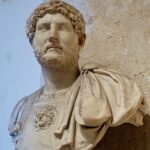Anyone with an understanding of the biographies of Roman emperors is aware of Hadrian’s familiarity with his favorite Antinous. His beloved traveled with the emperor in the provinces, but during his visit to Egypt, he drowned in the waters of the Nile.
This incident was for Hadrian very unpleasant and resulted in the cult of Antinous, which quickly became popular. This is the commonly known version of these events, depicting Hadrian as a person who, by a twist of fate, lost a loved one. Anthony Birley in his book However, “Hadrian. The Tireless Emperor” presents a more interesting look at these events. It is certain that Hadrian, as a fan of Greek culture and a frequent visitor to Athens, was initiated into the Eleusinian Mysteries – a mysterious rite related to the cult of Demeter and her daughter Persephone, taking the theme of death and rebirth as its leading point.
It is also worth knowing that during his reign, Hadrian’s health began to deteriorate more and more (he took power at the age of 41). During the celebration of the aforementioned mysteries, he was to learn that only the sacrifice of a close and healthy person can give him vigor and vitality. This coincided with the progressive campaign by the conservative Romans over the unusual relationship between the emperor and Antinous. Hadrian could thus kill two birds with one stone – make the sacrifice necessary for recovery and deprive the opposition of a strong argument of criticism. Antinous must have complied with Hadrian’s suicide order and deliberately drowned himself in the Holy Nile (the choice of the site was clearly not accidental), which was then faked in an accident.
An important argument to support this thesis are the depictions of Hadrian on statues – before Antinous’s death, he did not care about idealizing his image, he was presented adequately to his age and progressive disease. When Antinous was killed in the waters of the Nile, the image of Hadrian depicted in the sculptures changed significantly. He presented himself rejuvenated and full of vitality – as if Hadrian needed confirmation of the rightness and action of a sacrifice he had ordered himself.







